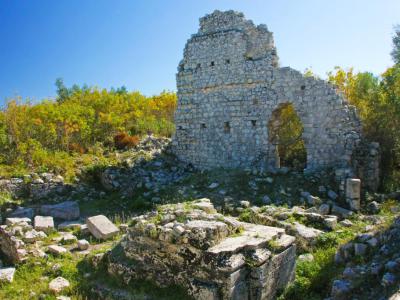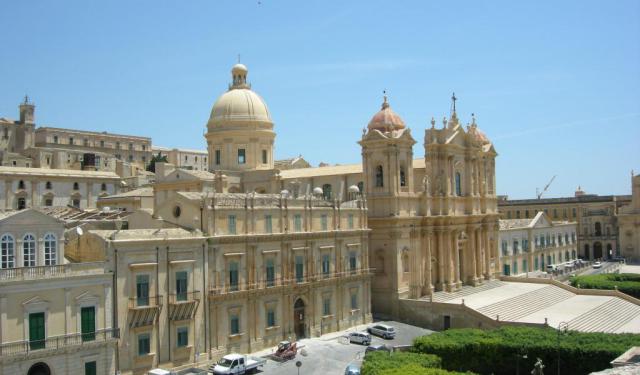
Chiesa e Collegio dei Gesuiti (Jesuit Church and College), Noto
Directly across from Palazzo Belludia, the remnants of the church and Jesuit college can be found, strategically positioned in the heart of the city. As you stand here today, near a pathway fork marked by a small commemorative shrine, it's worth noting that in the 17th century, this square served as the city's principal square. The Jesuit complex, an architectural gem initiated in 1606 and constructed in the Baroque style, was the work of Jesuit architect Natale Masuccio da Malta.
Tragically, like the rest of Noto, the church of the Jesuit Order in the ancient city fell victim to the earthquake that ravaged the eastern part of Sicily in 1693. Recent research efforts have shed light on the complex history of this edifice, even allowing for the creation of a 3D model depicting a hypothetical reconstruction of the complete church.
Through the examination of surveys and historical records, it has been determined that the church remained unfinished at the time of the earthquake. Furthermore, the layout of the ruins does not align with the known architectural drawings from the first half of the 17th century. An analysis of the ruins indicates that the Jesuits of Noto had envisioned the construction of a monumental church, necessitating the demolition of a portion of an existing structure to make way for the new edifice.
Tragically, like the rest of Noto, the church of the Jesuit Order in the ancient city fell victim to the earthquake that ravaged the eastern part of Sicily in 1693. Recent research efforts have shed light on the complex history of this edifice, even allowing for the creation of a 3D model depicting a hypothetical reconstruction of the complete church.
Through the examination of surveys and historical records, it has been determined that the church remained unfinished at the time of the earthquake. Furthermore, the layout of the ruins does not align with the known architectural drawings from the first half of the 17th century. An analysis of the ruins indicates that the Jesuits of Noto had envisioned the construction of a monumental church, necessitating the demolition of a portion of an existing structure to make way for the new edifice.
Want to visit this sight? Check out these Self-Guided Walking Tours in Noto. Alternatively, you can download the mobile app "GPSmyCity: Walks in 1K+ Cities" from Apple App Store or Google Play Store. The app turns your mobile device to a personal tour guide and it works offline, so no data plan is needed when traveling abroad.
Chiesa e Collegio dei Gesuiti (Jesuit Church and College) on Map
Sight Name: Chiesa e Collegio dei Gesuiti (Jesuit Church and College)
Sight Location: Noto, Italy (See walking tours in Noto)
Sight Type: Religious
Guide(s) Containing This Sight:
Sight Location: Noto, Italy (See walking tours in Noto)
Sight Type: Religious
Guide(s) Containing This Sight:
Walking Tours in Noto, Italy
Create Your Own Walk in Noto
Creating your own self-guided walk in Noto is easy and fun. Choose the city attractions that you want to see and a walk route map will be created just for you. You can even set your hotel as the start point of the walk.
Archaeological Park of Ancient Noto Tour
The Archaeological Park of Ancient Noto encompasses several archaeological areas that broadly include Ancient Noto (Noto Antica) in the south and Necropolis in the North. The former area, especially on the side of of the Mountain Gate (Porta della Montagna), an imposing structure serving as an entrance to this historical city, is bounded by the imposing 16th-century walls that withstood... view more
Tour Duration: 2 Hour(s)
Travel Distance: 3.7 Km or 2.3 Miles
Tour Duration: 2 Hour(s)
Travel Distance: 3.7 Km or 2.3 Miles
Noto Introduction Walking Tour
Perched high on a plateau with a panoramic view of the Asinaro Valley, in the shadow of Mount Alveria, the city of Noto is renowned as the Baroque capital of Sicily.
The name "Noto" finds its roots in the ancient Greek word "Neaton," which is likely translated to "south". Later, it was Romanized as "Netum." The Romans granted this territory to Hiero II... view more
Tour Duration: 1 Hour(s)
Travel Distance: 0.9 Km or 0.6 Miles
The name "Noto" finds its roots in the ancient Greek word "Neaton," which is likely translated to "south". Later, it was Romanized as "Netum." The Romans granted this territory to Hiero II... view more
Tour Duration: 1 Hour(s)
Travel Distance: 0.9 Km or 0.6 Miles


